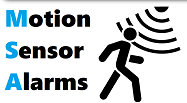Lighting allows for certain practical or imaginative, and even dramatic effect. However, one of the most obvious ways to utilize lighting is for the purpose of adding security to our properties.
Nothing deters a wood-be burglar faster than a bright light suddenly shining on them while they are trying to remain unseen.
Outdoor wireless motion sensors alarm systems that control the lights are convenient for the family. Whenever you come home, they will illuminate your way so that you can avoid stumbling. Moreover, you won’t be fumbling around in the dark for your keys while your hands are full.
The Benefits of Outdoor Wireless Motion Sensors
The ability to control the supervision of your property is priceless. Thanks to wireless technology, outdoor wireless motion sensor alarms are an effective security measure.
With a series of motion sensors spread around your property, implementing procedures of defense against intruders becomes almost instant. However, some of the most important and sometimes overlooked benefits of these sensors include:
Save money: Outdoor wireless motion sensors alarms that control your lights will save you money. There’s no better way to incur high electricity bills than leaving your lights on to burn all day.
Why not have the lights only activate when someone enters the area. It may be someone trespassing, or simply you arriving home.
But with outdoor motion sensors installed, your lights will only come on when you want them to or when it’s really needed.
Pest control: Motion lights can really clear an area, especially from fuzzy little unwelcome visitors like lawn rabbits, or squirrels, raccoons, and skunks. These little pests usually beat the bush when confronted by a bright light, not unlike regular burglars.
Flexibility: Using wireless motion sensors make it possible to monitor areas that would be too complicated to install security units. They can see through or behind obstacles or be installed in areas where cabling is impossible.
No interruptions: Wireless motion sensors are not dependent on the grid, but instead, operate on batteries. Sure, this means that you have to change batteries from time to time, but you’ll also be assured of them working no matter if there are power outages.
Cons of a wireless motion sensor alarm system
Of course, outdoor wireless motion sensor alarm systems are not perfect and come with their own share of cons.
We’ve already mentioned that changing batteries can be a problem for some. Without batteries, your alarm system will be rendered useless. But for most people, this isn’t a deal-breaker.
Wireless motion sensors also have a limited range. By utilizing radio waves between the sensor and the centralized alarm system, your sensors will be limited to be placed within a certain range. Should the sensors be placed outside of radio range, they will not be able to trigger your alarm.
Outdoor Motion Sensor and Pets
Just because outdoor wireless motion sensor alarms are supposed to ignore movements from pets, they often don’t. To effectively ignore all outdoor movement from pets, outdoor sensors must be equipped with two infrared sensors that have to trigger both in order to set off an alarm.
When selecting your outdoor wireless motion sensor alarm system, remember that features vary by manufacturer and model. Passive infrared sensors (PIR) ignore animals up to a certain weight. They often have selectable sensitivity for pets up to 40 pounds or those weighing up to 80 pounds.
Dual technology sensor alarm systems usually set off fewer false alarms due to the nature of the setup. As the name suggests, dual technology allows more than one device to work in tandem with each other. They are set up in such a manner that to only detect specific alarm conditions before triggering. These are more tolerant and resistant to animals wandering around the property.
